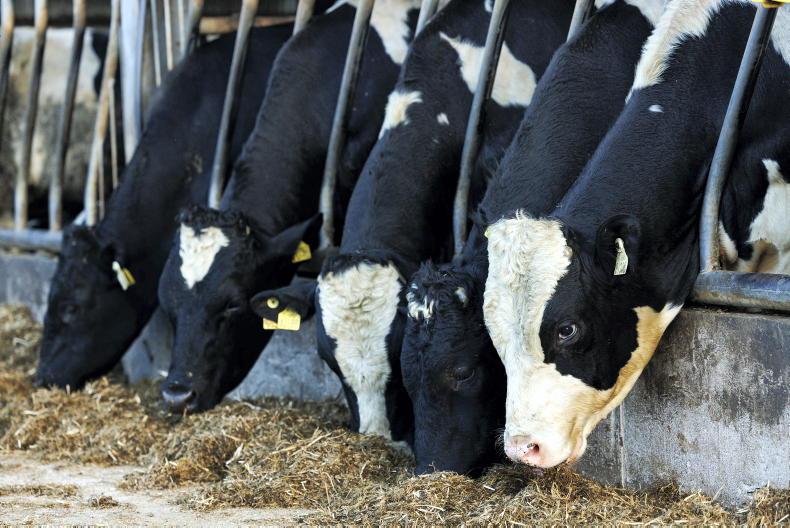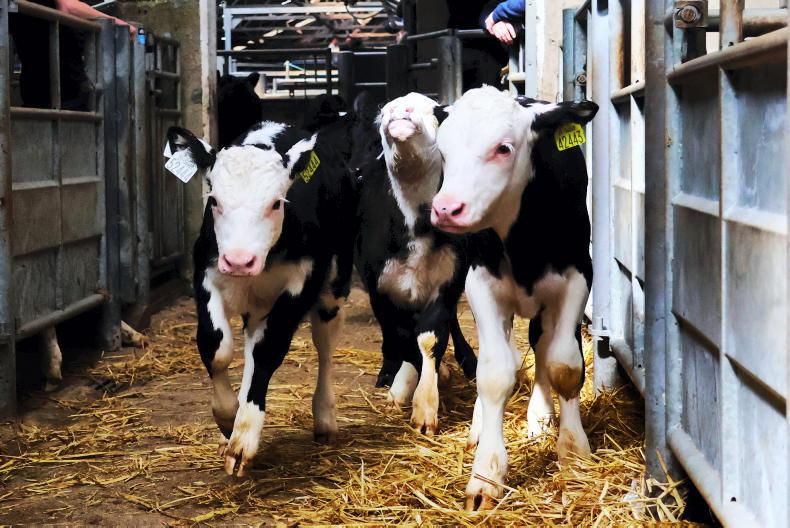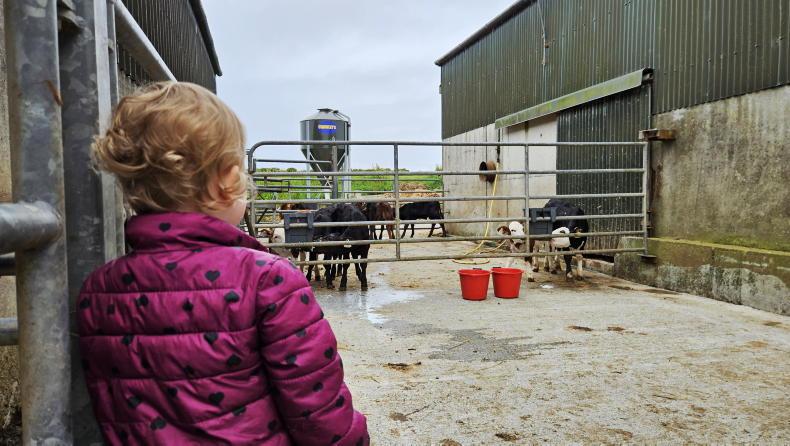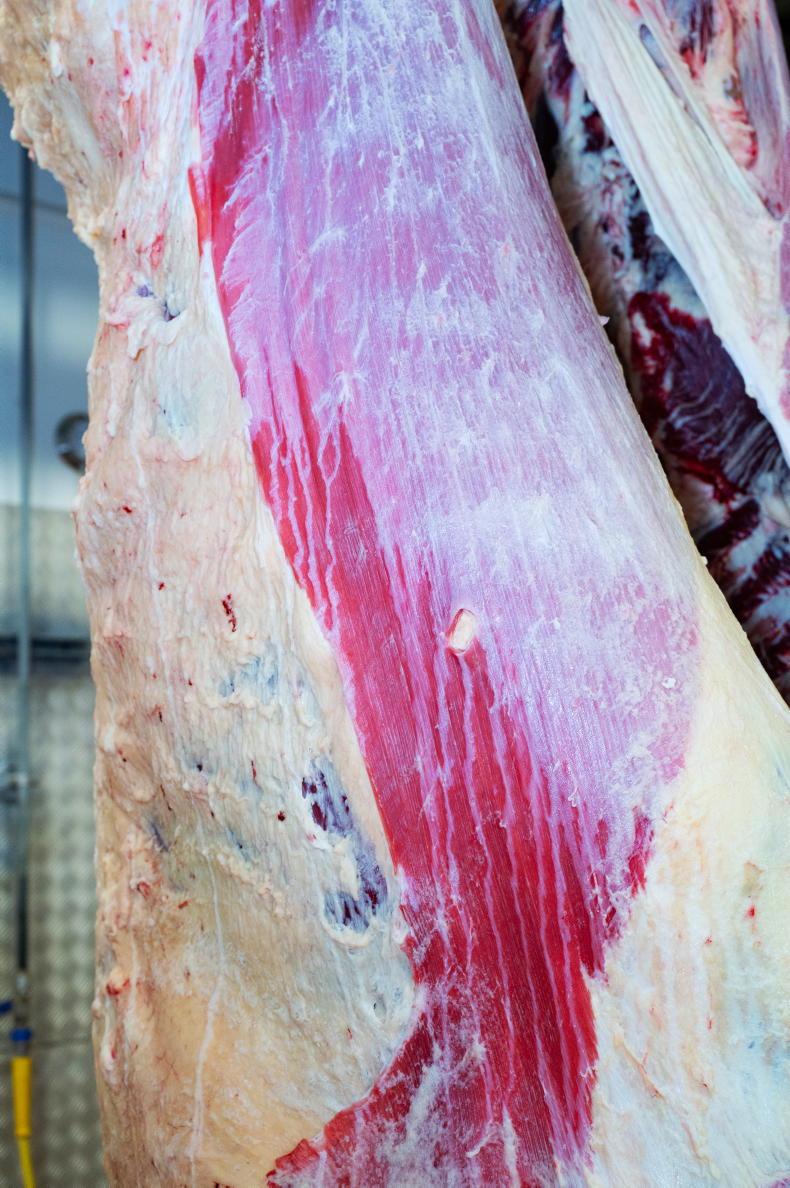Pat Collins and his family run a mixed farm consisting of tillage and dairy calf to beef.
The tillage crops consist of winter wheat, winter barley, oilseed rape, spring barley, beans, maize and sugar beet with many of them retained on farm for feeding with excess sold.
There are 130 acres of grass currently on the farm and, in 2023, 330 calves were purchased, the majority of which were Friesian bull calves along with 38 heifers.
The bulls will all be finished as 20-month bulls while the heifers will either be finished off grass in September to October 2024 or sold as forward stores.

A general view of some of the dairy-bred calves on the farm of Pat Collins, Dower, Castlemartyr, Co Cork during the Dairy Beef 500 farm walk on his farm. \ Donal O'Leary
Bulls are generally housed in August where they move on to an intensive finishing diet with a target slaughter date of September/October each year. The target is to get the bulls to a 300kg to 330kg carcase.
Weight gains
Calves are purchased in at 45kg and spend about 10 weeks on milk gaining 0.7/kg/day during this time. They are weaned once they are consuming 2kg of meal and weigh around 85kg to 95kg. They go to grass in mid-May and spend about six months at grass gaining 0.75/kg day at grass.
They are housed at 230kg in mid-November where they are fed high-quality silage and concentrates during the winter.
The target is to have them at 290kg at turnout in mid-February. The farm is a dry grazing farm and Pat said: “I’d have no hesitation at turning out weanlings in January if the weather and ground conditions were right. We might have to put them back in again but it’s a big saving in feed to get them out.”
The target is to get 5.5 months at grass for the second grazing season with the bulls housed in mid- to late August at an average weight of 460kg.
The bulls then go on to their finishing diet for approximately three months with a target slaughter weight of 580kg at the end of October.
Pat is targeting a 1.3kg/day gain during the finishing phase. The finishing diet is based on a high cereal ration, along with sugar beet fed as a total mixed ration. Calf ration is the only animal feed purchased on the farm.
Signpost programme
Pat is a participant in the Teagasc Signpost programme and the DairyBeef 500 programme, which sets out key targets for dairy calf to beef farms to hit for the duration of the programme.
One of the headline targets is to achieve a net margin of €500/ha, excluding land and family labour.
Reduced slaughter age, high-quality silage and achieving 200 to 240 days at grass are also key targets for the participating farmers.
Pat said: “Profit is number one on this farm, so if there’s a technology that can deliver for the environment and it can also deliver a positive to my bottom line, we’ll use it.

Pat Collins' farm. \ Donal O' Leary
“All of our slurry is now applied using a trailing show tanker and we have moved to growing red clover for silage and we also started grazing some multispecies swards, which I’m really happy with. To date, 15 units/acre of chemical nitrogen have been applied to the multispecies grass swards, while 80 units of chemical nitrogen have been applied to the permanent pasture. A red clover silage crop has been cut four times in 2023.”
Fat cover
While factory sentiment towards bulls has waned in recent years, Pat has stuck with them.
He has developed a relationship with Kepak and they are happy with the performance of the bulls and the level of fat cover that the bulls are coming in at.
Speaking at the farm event, Jonathan Forbes from Kepak said: “When bulls are done well, we have jobs for them. Fat cover is extremely important when finishing bulls and we are looking for a 3+ which Pat is hitting. If animals are kept performing right through their lifetime, hitting required fat scores shouldn’t be an issue.”
Pat’s system is impressive in terms of the returns he is getting from it. It’s a high-input, high-risk system but Pat is using his strengths as a tillage farmer to insulate himself against some of his costs. The farm is unique in that within the figures outlined in Table 1 is a cost for hired labour and a cost for leased land.
Output hit €6,256 in 2022 on the back of increased animal numbers and a better beef price.
Gross margin increased to €1,865/ha with net margin settling at €768/ha.
Pat Collins and his family run a mixed farm consisting of tillage and dairy calf to beef.
The tillage crops consist of winter wheat, winter barley, oilseed rape, spring barley, beans, maize and sugar beet with many of them retained on farm for feeding with excess sold.
There are 130 acres of grass currently on the farm and, in 2023, 330 calves were purchased, the majority of which were Friesian bull calves along with 38 heifers.
The bulls will all be finished as 20-month bulls while the heifers will either be finished off grass in September to October 2024 or sold as forward stores.

A general view of some of the dairy-bred calves on the farm of Pat Collins, Dower, Castlemartyr, Co Cork during the Dairy Beef 500 farm walk on his farm. \ Donal O'Leary
Bulls are generally housed in August where they move on to an intensive finishing diet with a target slaughter date of September/October each year. The target is to get the bulls to a 300kg to 330kg carcase.
Weight gains
Calves are purchased in at 45kg and spend about 10 weeks on milk gaining 0.7/kg/day during this time. They are weaned once they are consuming 2kg of meal and weigh around 85kg to 95kg. They go to grass in mid-May and spend about six months at grass gaining 0.75/kg day at grass.
They are housed at 230kg in mid-November where they are fed high-quality silage and concentrates during the winter.
The target is to have them at 290kg at turnout in mid-February. The farm is a dry grazing farm and Pat said: “I’d have no hesitation at turning out weanlings in January if the weather and ground conditions were right. We might have to put them back in again but it’s a big saving in feed to get them out.”
The target is to get 5.5 months at grass for the second grazing season with the bulls housed in mid- to late August at an average weight of 460kg.
The bulls then go on to their finishing diet for approximately three months with a target slaughter weight of 580kg at the end of October.
Pat is targeting a 1.3kg/day gain during the finishing phase. The finishing diet is based on a high cereal ration, along with sugar beet fed as a total mixed ration. Calf ration is the only animal feed purchased on the farm.
Signpost programme
Pat is a participant in the Teagasc Signpost programme and the DairyBeef 500 programme, which sets out key targets for dairy calf to beef farms to hit for the duration of the programme.
One of the headline targets is to achieve a net margin of €500/ha, excluding land and family labour.
Reduced slaughter age, high-quality silage and achieving 200 to 240 days at grass are also key targets for the participating farmers.
Pat said: “Profit is number one on this farm, so if there’s a technology that can deliver for the environment and it can also deliver a positive to my bottom line, we’ll use it.

Pat Collins' farm. \ Donal O' Leary
“All of our slurry is now applied using a trailing show tanker and we have moved to growing red clover for silage and we also started grazing some multispecies swards, which I’m really happy with. To date, 15 units/acre of chemical nitrogen have been applied to the multispecies grass swards, while 80 units of chemical nitrogen have been applied to the permanent pasture. A red clover silage crop has been cut four times in 2023.”
Fat cover
While factory sentiment towards bulls has waned in recent years, Pat has stuck with them.
He has developed a relationship with Kepak and they are happy with the performance of the bulls and the level of fat cover that the bulls are coming in at.
Speaking at the farm event, Jonathan Forbes from Kepak said: “When bulls are done well, we have jobs for them. Fat cover is extremely important when finishing bulls and we are looking for a 3+ which Pat is hitting. If animals are kept performing right through their lifetime, hitting required fat scores shouldn’t be an issue.”
Pat’s system is impressive in terms of the returns he is getting from it. It’s a high-input, high-risk system but Pat is using his strengths as a tillage farmer to insulate himself against some of his costs. The farm is unique in that within the figures outlined in Table 1 is a cost for hired labour and a cost for leased land.
Output hit €6,256 in 2022 on the back of increased animal numbers and a better beef price.
Gross margin increased to €1,865/ha with net margin settling at €768/ha.











SHARING OPTIONS